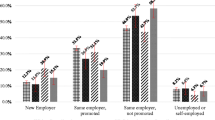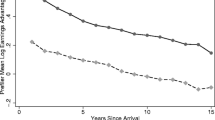Abstract
Motivated by recent findings of a diminishing earnings gap between the West Indians and other black workers, this study examines the earnings processes of immigrant and native-born West Indians in an effort to find the role of culture traits in their earnings. The decomposition of the earnings difference between immigrant and native-born West Indians indicates that a significant amount of the gap is unexplained by the observable labor market characteristics. Most of the observable human capital endowments of the immigrants are treated unfavorably by the market compared to those of the native-born West Indians. The earnings advantage of immigrants attributable to unobserved factors, however, turns out to be more than sufficient to overcome their market treatment adversity.
Similar content being viewed by others
References
Bean, Frank; Tienda, Marta.The Hispanic Population of the United States, New York, NY: Russell Sage Foundation, 1987.
Blinder, Alan S. “Wage Discrimination: Reduced Form and Structural Estimates,”Journal of Human Resources, 8, 4, Fall 1973, pp. 436–55.
Borjas, George J. “Assimilation, Changes in Cohort Quality, and the Earnings of Immigrants,”Journal of Labor Economics, 3, 4, October 1985, pp. 463–89.
Chiswick, Barry R. “Is the New Immigrant Less Skilled than the Old?,”Journal of Labor Economics, 4, 2, April 1986, pp. 168–92.
__. “An Analysis of the Economic Progress and Impact of Immigrants,” report prepared for the Employment and Training Administration, U.S. Department of Labor, 1980.
Cotton, Jeremiah. “On Decomposition of Wage Differential,”Review of Economics and Statistics, 70, 2, May 1988, pp. 235–43.
Glazer, Nathan; Moynihan, Daniel.Beyond the Melting Pot: The Negroes, Puerto Ricans, Jews, Italians, and the Irish of New York City, Cambridge, MA: MIT Press, 1963.
Hayes, George.The Negro at Work in New York City, New York, NY: Arno Press, 1968.
Model, Suzanne. “Caribbean Immigrants: A Black Success Story?, ”International Migration Review, 25, 2, Summer 1991, pp. 248–76.
Oaxaca, Ronald. “Male-Female Wage Differentials in Urban Labor Markets,”International Economic Review, 14, 3, October 1973, pp. 683–709.
Oaxaca, Ronald; Ransom, Michael. “On Discrimination and the Decomposition of Wage Differential,”Journal of Econometrics, 61, 1, March 1994, pp. 5–21.
Osofsky, Gilbert.Harlem: The Making of a Ghetto, New York, NY: Harper and Row, 1963.
Sowell, Thomas.Ethnic America, New York, NY: Basic Books, 1981.
__. “Three Black Histories,” in Thomas Sowell, ed.,Essays and Data on American Ethnic Groups, Washington, DC: The Urban Institute, 1978, pp. 7–64.
Woodbury, Stephen A. “Culture, Human Capital, and the Earnings of West Indian Blacks,” working paper 93-20, W.E. Upjohn Institute for Employment Research, September 1993.
Author information
Authors and Affiliations
Rights and permissions
About this article
Cite this article
Philip Jeon, B., Simmons, W.O. Reward for being an immigrant: Earnings gap between immigrant and native-born West Indians. Atlantic Economic Journal 26, 309–316 (1998). https://doi.org/10.1007/BF02299348
Issue Date:
DOI: https://doi.org/10.1007/BF02299348




